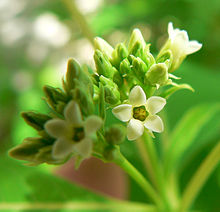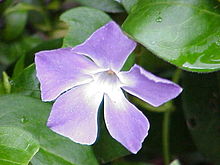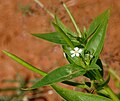Apocynaceae
This article needs additional citations for verification. (October 2011) |
| Apocynaceae | |
|---|---|

| |
| Apocynum cannabinum | |
| Scientific classification | |
| Kingdom: | |
| (unranked): | |
| (unranked): | |
| (unranked): | |
| Order: | |
| Family: | Apocynaceae |
| Type genus | |
| Apocynum | |
| Synonyms | |
Apocynaceae is a family of flowering plants that includes trees, shrubs, herbs, stem succulents, and vines, commonly called the dogbane family,[1] after the American plant known as dogbane, Apocynum cannabinum.[2] Members of the family are native to European, Asian, African, Australian, and American tropics or subtropics, with some temperate members.[1]
Many species are tall trees found in tropical rainforests, but some grow in tropical dry (xeric) environments. Also perennial herbs from temperate zones occur. Many of these plants have milky latex, and many species are poisonous if ingested. Some genera of Apocynaceae, such as Adenium, have milky latex apart from their sap, and others, such as Pachypodium, have clear sap and no latex.
Description

Growth pattern
The dogbane family includes annual plants, perrenial herbs, stem succulents, woody shrubs, trees, or vines.[1][3] Most[citation needed] exude a milky sap with latex[citation needed], if injured.
Leaves and stems
Leaves are not divided into smaller leaflets (simple). Leaves may appear one at a time (singly) with each occurrence on alternating sides of the stem (alternate),[3] but usually[citation needed] occur in pairs or in whorls. When paired, they occur on opposite sides of the stem (opposite), with each pair occurring at an angle rotated 90° to the pair below it (decussate).
There is no stipule (a small leaf-like structure at the base of the leaf stem), or stipules are small and sometimes fingerlike.[3]
Inflorescence and fruit
Flowers are usually[citation needed] showy, have radial symmetry (actinomorphic), and are born in head that are cymes or racemes, but can rarely be fasciculate or solitary. They are perfect (bisexual), with a synsepalous, five-lobed calyx united into a tube at the base. Inflorescences are terminal or axillary. Five petals are united into a tube with four or five epipetalous stamens. The style is expanded at the apex into a massive clavuncle just below the stigma. The ovary is usually superior, bicarpellary, and apocarpous, with a common fused style and stigma.
The fruit is a drupe, a berry, a capsule, or a follicle.
Taxonomy
The family comprises some 5,100 species.[4] Apocynoideae, Asclepiadoideae, Periplocoideae, Rauvolfioideae, and Secamonoideae are the 5 subfamilies of Apocynaceae as of 2012.[4] What is included in the family may change with new genetic data. The former family Asclepiadaceae is included in Apocynaceae according to the APG III system.[5] An updated classification, including 366 genera, 25 tribes and 49 subtribes, was published in 2014 (Endress 2014).[6]
Distribution and habitat

Species in this family are distributed mainly in tropical regions:
- In the rainforests and swamps of Indomalaya: small to very tall evergreen trees up to 80 m tall, often with buttress roots, such as Alstonia and Dyera
- In northern Australia: small evergreen trees such as Alstonia, Alyxia, Cerbera and Ochrosia
- In deciduous forests of Africa and India: smaller trees such as Carissa, Wrightia and Holarrhena
- In tropical America, India, Myanmar and Malaya: evergreen trees and shrubs, such as Rauvolfia, Tabernaemontana and Acokanthera
- In Central America: Plumeria, or the frangipani, with its waxy white or pink flowers and a sweet scent
- In South America, Africa and Madagascar: many lianas, such as Landolphia
- In the Mediterranean region: Nerium, with the well-known oleander or be-still tree (Nerium oleander)
- The only genera found in temperate Europe away from the Mediterranean are Vinca (Apocynoideae) and Vincetoxicum (Asclepiadoideae).
- In North America: Apocynum, dogbane or Indian hemp, including Apocynum cannabinum, a traditional source of fiber
- In continental southern Africa (Angola, Botswana, Mozambique, South Africa, Swaziland, and Zimbabwe) and Madagascar, except for the humid evergreen forest of the eastern side of Madagascar, and never above 2000 m for the entire island: Pachypodium and Fockea
Ecology
Several genera are preferred larval host plants for the Queen Butterfly (Danaus gilippus).[7]
Uses

Several plants of this family had economic uses in the past.
The genera Landolphia, Hancornia, Funtumia and Mascarenhasia were used as a commercial source of inferior rubber. (see Congo rubber, made largely from various Landolphia harvested from the wild under the most desperate conditions)
The juice of Acokanthera species such as A. venenata and the milky juice of the Namibian Pachypodium has been used as venom for arrow tips by the San (Bushmen). Some sources state that Pachypodium do not produce a milky latex.[8]
Several genera are grown as ornamental plants, including Amsonia (bluestar), Nerium (oleander), Vinca (periwinkle), Carissa (Natal plum, an edible fruit), Allamanda (golden trumpet), Plumeria (frangipani), Thevetia (lucky nut), Mandevilla (Savannah flower), Adenium (desert-rose).
Some are sources of important drugs, such as cardiac glycosides, which affect heart function. These include the Acokanthera, Apocynum, Cerbera, Nerium, Thevetia and Strophantus. Rauvolfia serpentina, or Indian Snakeroot, yields the alkaloids reserpine and rescinnamine, which are useful tools in the treatment of high blood pressure and even some forms of psychosis. Catharanthus roseus yields alkaloids used in treating cancer.
The genus Apocynum was used as a source of fiber by Native Americans.
The edible flower of Fernaldia pandurata (common name: loroco) is a popular part of El Salvadorian and Guatemalan cooking.
The aromatic juice of Saba comorensis (syn. Landolphia comorensis, the Bungo or Mbungo fruit is popular and highly appreciated on Pemba Island and other parts of coastal Tanzania.[9]
Gallery
References
- ^ a b c Endress ME, Bruyns PV (2000). "A revised classification of the Apocynaceae s.l.". The Botanical Review. 66 (1): 1–56. doi:10.1007/BF02857781.
- ^ Heiser CB (2003). Weeds in my garden: observations on some misunderstood plants. Portland, Oregon: Timber Press. p. 50. ISBN 0-88192-562-4.
- ^ a b c Apocynaceae, Thomas Rosatti, Jepson Herbarium
- ^ a b The taxonomy and systematics of Apocynaceae: where we stand in 2012; Nazia Nazar, David J. Goyder, James J. Clarkson, Tariq Mahmood and Mark W. Chase; Botanical Journal of the Linnean Society, Volume 171, Issue 3, pages 482–490, March 2013, [1]
- ^ Angiosperm Phylogeny Group (2009). "An update of the Angiosperm Phylogeny Group classification for the orders and families of flowering plants: APG III". Botanical Journal of the Linnean Society. 161 (2): 105–121. doi:10.1111/j.1095-8339.2009.00996.x.
- ^ Endress M.E., Liede-Schumann S. & Meve U. (2014). "An updated classification for Apocynaceae" (PDF). Phytotaxa. 159: 175–194. doi:10.11646/phytotaxa.159.3.2.
- ^ Klots, Alexander B. (1951). A Field Guide to the Butterflies of North America, East of the Great Plains. Cambridge, Massachusetts: The Riverside Press. pp. 77–79.
- ^ Rapanarivo SHJV, Leeuwenberg AJM (1999). "Taxonomic revision of Pachypodium. Series of revisions of Apocynaceac XLVIII". In Rapanarivo SHJV (ed.). Pachypodium (Apocynaceae): taxonomy, habitats and cultivation. Balkema. pp. 1–82. ISBN 978-90-5410-485-8.
- ^ "Saba comorensis in Agroforestree Database" (PDF). Retrieved 30 July 2012.






